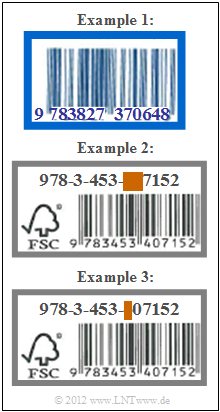Exercise 1.1: For Labeling Books
Since the 1960s, all books are provided with a 10-digit "International Standard Book Number" $\rm (ISBN)$. The last digit of this so-called ISBN-10 specification is calculated according to the following rule:
- $$ z_{10}= \left ( \sum_{i=1}^{9} \hspace{0.2cm} i \cdot z_i \right ) \hspace{-0.2cm} \mod 11 \hspace{0.05cm}.$$
Since 2007, the specification according to the standard ISBN-13 is additionally mandatory, whereby the check digit $z_{\rm 13}$ then results as follows:
- $$z_{13} = 10 - \left ( \sum_{i=1}^{12} \hspace{0.2cm} z_i \cdot 3^{(i+1)\mod 2} \right ) \hspace{-0.2cm} \mod 10 \hspace{0.05cm}.$$
Some exemplary "ISBNs" are given opposite. The following questions refer to these.
Hints: This exercise belongs to the chapter "Objective of Channel Coding"
Questions
Solution
- $$S \ = \ \hspace{-0.1cm} \sum_{i=1}^{13} \hspace{0.2cm} z_i \cdot 3^{(i+1) \hspace{-0.2cm} \cdot 2} = (9+8+8+7+6+8) \cdot 1 + (7+3+2+3+0+4) \cdot 3 = 110\hspace{0.3cm} \Rightarrow \hspace{0.3cm} S \hspace{-0.2cm} \mod 10 \hspace{0.15cm}\underline {= 0} \hspace{0.05cm}.$$
(2) The answer is No. Only one cancellation can be reconstructed with a single check digit.
(3) One digit can be reconstructed ⇒ Yes. For the digit $z_{\rm 8}$, it must hold:
- $$[(9+8+4+3+0+1+2) \cdot 1 + (7+3+5+z_8+7+5) \cdot 3] \hspace{-0.2cm} \mod 10 = 0\hspace{0.3cm} \Rightarrow \hspace{0.3cm} [108 + 3z_8] \hspace{-0.2cm} \mod 10 = 0 \hspace{0.3cm} \Rightarrow \hspace{0.3cm} z_8 \hspace{0.15cm}\underline {= 4} \hspace{0.05cm}.$$
(4) By the modulo 11 operation, $z_{10}$ can take the values $0,\ 1,\ \text{...} ,\ 10$ ⇒ $\underline{M =11}$.
- Since "10" is not a digit, one makes do with $z_{10} = \rm X$.
- This corresponds to the Roman representation of the number "10".
(5) The test condition is:
- $$\ \ S= \left ( \sum_{i=1}^{10} \hspace{0.2cm} i \cdot z_i \right ) \hspace{-0.2cm} \mod 11 = 0 \hspace{0.05cm}.$$
- The given ISBN satisfies this condition:
- $$3 \cdot 1 + 8 \cdot 2 + 2 \cdot 3 + 7 \cdot 4 + 3 \cdot 5 + 7 \cdot 6 + 0 \cdot 7 + 6 \cdot 8 + 4 \cdot 9 + 7 \cdot 10 = 264\hspace{0.3cm} ⇒\hspace{0.3cm} S= 264 \hspace{-0.3cm} \mod 11 = 0 \hspace{0.05cm}.$$
- Correct is statement 2, since the check sum $S = 0$ could result even with more than one error.
